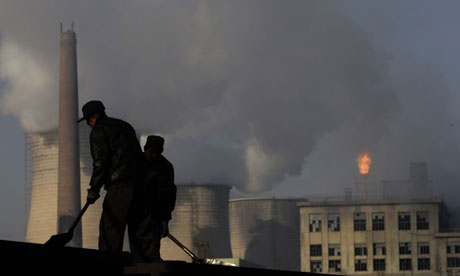If promises are kept, development finance is set to rise to $100bn. Shouldn’t we be investing this money in developing clean technologies?
At a workshop on climate change and the media, held by the Asia Europe Foundation ahead of the annual Asia Europe summit, I was struck by an argument put forward by Shell. One of their senior officials presented the company’s forecast of energy needs in 2050. According to Shell, there will be 2 billion more people on the planet by 2050 but, if everyone uses energy like theUS, it will be like having a planet of 72 billion people. Hopefully they won’t, so according to Shell’s guestimates, energy demand is likely to rise by about 64% in the developing world, and by 3% in the already industrialised world.

Overall, Shell reckons the world will need to be producing about twice as much energy in 2050 as we are today. But given climate constraints, this energy will have to be delivered with half as much CO2 pollution. How?
The main block to clean energy is making it affordable. With the technology we currently have, for the same unit of energy, coal costs $0.04, gas $0.08, wind $0.12 and solar a whopping $0.20.
The price of dirty energy has clearly got to go up. Coal provides 40% of the world’s energy, today, but in the US 80% of CO2 from power generation is from coal. This has a lot to do with absurd subsidies that are literally paying people to ruin the planet.
Somehow the cost of renewable energy has got to come down. Shell wants us to be realistic about how fast renewable technologies can come on stream in a big way. Liquid Natural Gas technology was first developed in 1964 and it produces just 2% of world energy. Wind energy started in the 1970s and produces just 1% today. To get those percentages into double digits will take decades, at that rate of technological advance.
But while Shell’s forecasting is certainly worth listening to, they get it wrong on technology. In decades past, investment in research and development to bring technologies forward has been a fraction of what was required. If we were to invest more, progress would be rapid. It is the difference between having 1,000 universities working on a problem instead of 100.
Deep K Datta-Ray, of the Times of India, says India’s position on climate change had shifted dramatically in recent years. The continent has gone from being reticent about accepting responsibility to act – arguing that India’s impact on global warming has been minimal, and it already faced with the problem of lifting hundreds of millions of people out of poverty – to taking a strategic decision to become a climate change leader.
What prompted the change of heart? Simple. Forget the international wrangling over whose fault it is, it is in India’s national interest to act, based on a basic cost-benefit analysis.
First, 70% of Indians depend in some way on agriculture. The smallest shift in the timing of the monsoon, or in the amount of rainfall, drastically affects agricultural yields.
Second, 300 million people live by the coast – a rise in sea levels matters.
Third, glaciers are retreating in the north of India, directly affecting the huge water needs the country has.
And fourth, there is a tension between the need to continue to extract raw materials for development and export, while at the same time protecting the greenest parts of India, where these materials are found.
With clean technology incorporated into the manufacturing base, the products required to lift millions of Indians from poverty could be made with much less carbon pollution.
The key is what India is doing about it. While China has become the world’s manufacturing hub in recent years and India wants to become its research hub. Billions of dollars have already been set aside for research. The main focus of Indian civil servants at the Cancun summit was influencing the agreement’s section on technology, because that is where it believes it has the most to offer, and the most to gain.
Crucially, India’s ability to make significant changes rapidly is similar to that of China’s. Some 70% of economic activity is carried out by the Indian state even after years of liberalisation, meaning that ideas formulated in the centre can be spread to different localities across the huge sub-continent to see what works. In contrast, President Obama is struggling to get even a minimal cut in US emissions of 2% to 3% on 1990 levels through Congress.
Pessimism about the speed with which humanity can develop clean energy is misplaced. Research is the missing factor in the predictions made by Shell and others. But it won’t come cheap. While India and China (which has the world’s largest solar power industry) continue to invest in research out of clear national self interest, and while pioneers in Europe and the US do the same, the international community should use its money smartly.
Climate finance is the new kid on the block in international development finance, set to rise to US$100bn by 2030 if promises are kept. That is almost as much as the entire aid budget. But so far almost none of it is allocated to research and development. Instead, complex schemes paying poor countries to produce less CO2 and helping them cope with a changing climate are being developed.
As a thought experiment, just imagine what would happen if all that money were invested in research instead of preparing for climatic crisis? Might an R&D revolution in clean technology actually save the planet?
 Follow
Follow